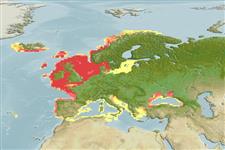Environment: milieu / climate zone / depth range / distribution range
Ecologia
marinhas; estuarina bentopelágico; oceanódromo (Ref. 51243); intervalo de profundidade 10 - 200 m (Ref. 1371), usually 30 - 100 m (Ref. 1371). Temperate; 72°N - 35°N, 27°W - 42°E
Northeast Atlantic: southeastern Barents Sea and Iceland to Portugal, also in the Black Sea, Aegean Sea, Adriatic Sea and adjacent areas. Rare in the northwestern Mediterranean.
Length at first maturity / Tamanho / Peso / Idade
Maturity: Lm 28.2, range 28 - 30 cm
Max length : 91.5 cm TL macho/indeterminado; (Ref. 106276); common length : 23.5 cm TL macho/indeterminado; (Ref. 1371); peso máx. Publicado: 3.1 kg (Ref. 40637); Idade máx. registada: 20 anos (Ref. 35388)
Espinhos dorsais (total): 0; Raios dorsais moles (total): 30-40; Raios anais moles: 30 - 35. Body elongate; head small. Chin barbel small or absent. Lateral-line canals on head with pores. Color is variable; yellowish-brown, dark blue or green, sides yellowish grey, white and silvery on belly; often with a small dark blotch at the upper base of the pectoral fin.
More commonly found from 30 to 100 m, mainly on mud and gravel bottoms, but also on sand and rock. Feed on shrimps, crabs, mollusks, small fish, polychaetes and cephalopods. Migrate to the open sea only after the first year of life. Eggs are pelagic. Larvae and juveniles are associated with jellyfish. Upon maturity, small chin barbel characteristic of juveniles disappear (Ref. 53061). Spawn in batches (Ref. 51846). Utilized fresh, dried or salted, smoked and frozen; eaten steamed, broiled and baked (Ref. 9988).
Oviparous, sexes are separate (Ref. 205).
Cohen, D.M., T. Inada, T. Iwamoto and N. Scialabba, 1990. FAO species catalogue. Vol. 10. Gadiform fishes of the world (Order Gadiformes). An annotated and illustrated catalogue of cods, hakes, grenadiers and other gadiform fishes known to date. FAO Fish. Synop. 125(10). Rome: FAO. 442 p. (Ref. 1371)
Categoria na Lista Vermelha da IUCN (Ref. 130435)
Ameaça para o homem
Harmless
Utilização humana
Pescarias: altamente comercial; peixe desportivo: sim; Aquário: Aquários públicos
Ferramentas
Relatórios especiais
Descarregue XML
Fontes da internet
Estimates based on models
Preferred temperature (Ref.
123201): 7 - 11.9, mean 9.2 °C (based on 409 cells).
Phylogenetic diversity index (Ref.
82804): PD
50 = 1.0000 [Uniqueness, from 0.5 = low to 2.0 = high].
Bayesian length-weight: a=0.00617 (0.00548 - 0.00694), b=3.06 (3.02 - 3.10), in cm total length, based on LWR estimates for this species (Ref.
93245).
Nível Trófico (Ref.
69278): 4.4 ±0.2 se; based on diet studies.
Generation time: 3.8 (3.3 - 4.4) years. Estimated as median ln(3)/K based on 60
growth studies.
Resiliência (Ref.
120179): Médio, tempo mínimo de duplicação da população 1,4 - 4,4 anos (rm=1.1-1.6(?); K=0.07-0.74; tm=1-4; tmax=20; Fec>100,000).
Prior r = 0.49, 95% CL = 0.33 - 0.74, Based on 17 stock assessments.
Fishing Vulnerability (Ref.
59153): Moderate to high vulnerability (46 of 100).
Climate Vulnerability (Ref.
125649): Moderate to high vulnerability (47 of 100).
Nutrients (Ref.
124155): Calcium = 18 [9, 36] mg/100g; Iron = 0.2 [0.1, 0.6] mg/100g; Protein = 18 [16, 20] %; Omega3 = 1 [0, 2] g/100g; Selenium = 17.8 [8.2, 36.9] μg/100g; VitaminA = 11.9 [3.0, 48.0] μg/100g; Zinc = 0.242 [0.129, 0.709] mg/100g (wet weight); based on
nutrient studies.
